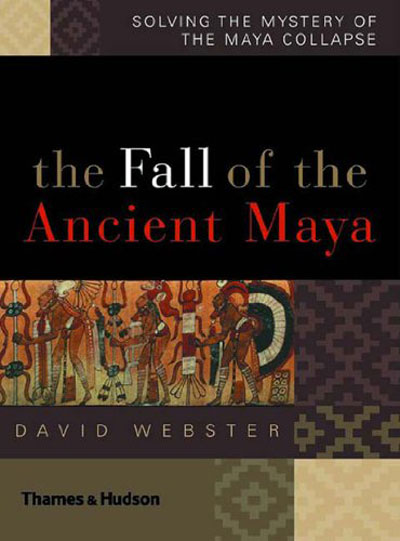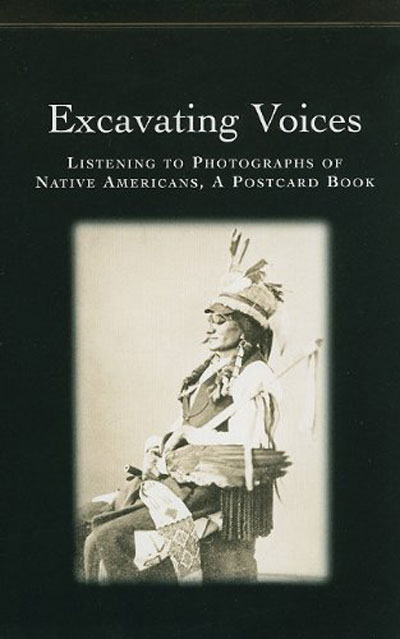
By David Webster (London: Thames and Hudson, 2002), 368 pp, 55 figures, 29 plates, cloth, $34.95.
Review by Charles Golden
It is impossible for anyone — whether an archaeologist or a casual tourist — to explore the ruins of a Classic period Maya site and not imagine what must have been, and what was lost. It is particularly true at a site like Copan, its courtyards filled with sculptures bearing the visages and histories of its dead kings. Embracing the stories that we all create in our minds, Webster uses this vehicle to raise important issues that were involved in the social and political collapse of the eighth and ninth centuries A.D.
From the opening chapter the writing in The Fall of the Ancient Maya stands apart from the dry and stilted prose of many academic works about the Maya. As the king watches the sun rise, he ponders the changes taking place in his kingdom: political factions rising in power, increasingly violent conflicts elsewhere in the Maya area, and environmental degradation. All these themes are explored in detail later in the volume, and by introducing them in this way Webster ensures that readers carry these central themes in mind as they explore the more detailed archaeological narratives in subsequent chapters.
Webster moves methodically but briskly through lines of evidence to build his argument for the collapse of the Classic period “Great Tradition.” He moves from the Colonial back to the Preclassic period, showing the many trajectories of evidence that archaeologists use to reconstruct Classic Maya society. He demonstrates that there was no one Maya Collapse, but that there was, within a cycle of growth and disintegration, a dramatic sociopolitical breakdown in the eighth and ninth centuries.
Webster also looks at how evidence has been used by archaeologists, highlighting the inherent problems with many of the arguments made about the ancient Maya. Even readers who are not archaeologists have at their disposal the pieces of the puzzle and the building blocks to decide which version of the collapse to believe.
Webster, of course, has a very definite idea about what he believes happened, and he makes no bones about his dismay with the arguments made by some other researchers, particularly those who “bend” the data to fit their arguments. Although his perspective on the collapse has at its core an essentially Malthusian, ecological orientation — the Maya outstripped their resources, resulting in biological and social pressures that ripped society apart — this does not mean that he ignores the ideological and immaterial foundations of Maya society and causes of collapse. To the contrary, Webster’s exploration of the collapse is one of the most even-handed treatments of the subject to date.
In terms of content, The Fall of the Ancient Maya does both more and less than its title might promise. It does more because Webster traces all the threads of Maya civilization from its inceptions to the Spanish Conquest. He weaves a complex picture of a complex problem. And he rightly justifies himself in defying reader expectations in this way, since there is no way to understand the “fall” of the Ancient Maya without understanding what was lost.
It does less because Webster provides no easy answer for the reader. He warns the reader in the prologue that there will be no simple answer to the question of why the Maya fell, and he reminds us in the epilogue that we were warned about such a potentially unsatisfactory ending to his historical overview. But the reader should not feel cheated in finding no single answer. Webster’s story is complex and richly illustrated, with both figures and personal stories of his experiences as an archaeologist. The Fall of the Ancient Maya is clearly aimed at a broad reading public that includes as much the hardcore Maya enthusiast as the casual reader, tourist, and student. Webster’s writing is entertaining while informative, making this book, even at 368 pages, a quick read.
Charles Golden is a research associate of the American Section of the Museum and is director of the Sierra del Lacandon Regional Archaeology Project in Guatemala.

Michael Katakis, ed. (University of Pennsylvania Museum, 1998), 76 pp, 48 photographs, cloth ($39.95) and paper ($24.95).
Review by Deward E. Walker, Jr.
The use of photography to represent American Indians began in the mid-19th century as a historical effort that quickly settled into an artistic one, designed to present posed portraits of American Indian subjects, especially famous ones. Beginning in the 19th century, photography became an important tool in anthropology, history, and museology. More recently, photography has become a major political tool employed by American Indians in their survival struggle. A stepping-stone toward understanding 19th- and early-20th-century American Indian culture, Excavating Voices: Listening to Photographs of Native Americans is a sampler of the 300,000 photos in the Museum’s Archives. The book focuses on the Notable Photographer’s Collection, which contains works of such famous photographers as William Henry Jackson, Jessie Tarbox Beals, and Edward Curtis.
Excavating Voices raises a number of disturbing questions that continue to concern scholars of the American Indian. What is the purpose of such collections of portraits? Do the photographs reflect cultural bias and ethnocentrism? For example, Michael Katakis, author and volume editor, writes,“We do not glean from these early photographs a sense of American Indians as individuals with dreams, hopes, sorrows, even flaws.” Most of the photographs are posed portraits, three-quarter shots or closer, serving Katakis’s aims of interpreting the subjects by the “look” in their eyes but not by placing the subject in his or her cultural context. The Indians’ ordinary lives are not part of these photos. Only 15 of the 48 photos show the subjects in pairs or groups, and most of the photos are, admittedly, either studio shots or have been doctored to remove “un-Indian” items such as umbrellas and hats. With more than 300,000 photos archived, Excavating Voices could have been greatly improved by the choice of less-well-known photographs that revealed more cultural content.
In the essay “Fugitive Poses,” Gerald Vizenor, of the University of California, Berkeley, observes, “the notion that a photograph is worth a thousand words is untrue in any language.” Vizenor detects obvious racism and ethnocentrism in the photographs. Quoting Susan Sontag in On Photography, he seems to agree that “there is something predatory in the act of taking a picture.” Vizenor’s essay also appears to accuse the reader of racism and ethnocentrism not only because someone in the 19th century took a photograph, but also because someone now wants to view it. He accuses the photographers of “simulating Indianness” and “colonizing through photography” and ends by saying, “Ethnographic portraiture is an oxymoron of dominance.”
Robert W. Preucel’s essay,“Learning from the Elders,” suggests how a photograph can speak. To Preucel, associate curator in the American Section of the University of Pennsylvania Museum and associate professor of anthropology at the University of Pennsylvania, the photos tell a story of cultural dominance, progress, technology, and “reality.” Preucel claims that beneath the distortions and limitations, the voices of American Indians still whisper. They are the meat of the photographs under the garnish of what non-Indians expect them to be.
The real issue the essays seem to raise is how does a photographer take a portrait that says more about its subject than its maker. Certainly the limitations experienced by the photographers make it easier to understand why the American Indian subjects were photographed in stylized forms. Perhaps this is the true point of the book— that is, that we cannot fully understand the past from photographs or a subject from his or her posed portrait. Excavating Voices speaks about the photographers, but less so of their subjects, who remain elusive. The enduring challenge of this book to all of us, then, is how to penetrate beyond the surface “reality” of this and many similar collections of American Indian portraits.
Deward E. Walker, Jr., is professor of anthropology and ethnic studies at the University of Colorado in Bolder.
